
Arkforce was an ad hoc formation of the British Expeditionary Force during the Battle of France in 1940.

Arkforce was an ad hoc formation of the British Expeditionary Force during the Battle of France in 1940.

At the start of the Battle of France, the 51st (Highland) Infantry Division was on detachment from the rest of the BEF, having been reinforced, to man part of the Maginot Line under French command. After being withdrawn and sent west, the division was attached to IX Corps of the French Tenth Army in Normandy along the lower reaches of the river Somme. Command of the corps was given to Major-General Victor Fortune of the Highland Division, who was under the command of General Robert Altmayer the Tenth Army commander. After almost continuous fighting against a German bridgehead on the south bank at Abbeville, the division was ordered to retreat on 7 June, to a 13 mi (21 km) defensive line along the river Bresle. When the second German offensive Fall Rot (Case Red) reached the area the next day, the 5th Panzer Division outflanked the Bresle position at Rouen, leaving the Highlanders and the French 31st Division cut off from their line of retreat across the River Seine. [1] Fortune decided to ignore orders from Altmayer and the War Office to retire towards the Seine (through an area now occupied by several German divisions) and to head for the port of Le Havre, taking the rest of IX Corps with him. [2]

The units grouped into Arkforce were near Arques-la-Bataille and its name was derived from village. Arkforce was to form a defensive line about 19 mi (30 km) to the east of Le Havre, on the Fécamp–Bolbec line, to allow the 51st Highland Division and the rest of IX Corps to retreat. It was also charged with providing the reconnaissance for a line of defence closer to Le Havre, to aid the evacuation. [3] [4]
Due to congested roads, units were late arriving and elements of the 7th Panzer Division were already driving between Arkforce and the rest of IX Corps. Arkforce moved on the night of 9/10 June towards Fécamp, where most had passed through before the 7th Panzer Division arrived. A Brigade managed to force its way out but lost the wireless truck intended to keep contact with the 51st (Highland) Division. The possibility of holding a line from Fécamp to Lillebonne was discounted and Stanley-Clarke ordered Arkforce on to Le Havre. [5] The port was severely bombed by the Luftwaffe on 7 June; a Royal Navy demolition party had been in Le Havre since late May and two days later, the Admiralty sent orders for an evacuation. Admiral William James, the Commander-in-Chief, Portsmouth sent a flotilla leader, HMS Codrington across the channel, accompanied by six British and two Canadian destroyers, smaller craft and many Dutch coasters (known as schuyts). [6]
A hasty plan was made to block Dieppe harbour and on 10 June, HMS Vega (Captain G. A. Garnon-Williams) escorted three blockships to the port. Two ships were sunk in the approach channel but the third ship hit a mine just outside, which prevented it being sunk at the entrance to the inner harbour. [6] (James had signalled that many IX Corps troops would probably be trapped against the sea near St. Valery, where he had assembled flotillas of smaller craft under the local Senior Naval Officer.) [7] Beach parties landed at Le Havre to take control of the evacuation on 10 June and after a postponement, the evacuation began on 11 June, hindered somewhat by the damage to the port caused by Luftwaffe bombing. The troopship SS Bruges, was hit and beached and the electric power to the docks was cut, rendering the cranes on the docks useless; ramps were tried for vehicle loading but it was too slow. On 12 June, RAF fighters began patrolling the port to deter raids. An attempt was made to save the transport and equipment by diverting it over the Seine, via the ferry crossings at Caudebec or to the ships at Quillebeuf at the river mouth. The quartermaster of the 14th Battalion, Royal Fusiliers succeeded in getting his transport away. [8]
Arkforce Data from Joslen (2003) unless indicated. [9]

Operation Cycle is the name of the evacuation of Allied troops from Le Havre, in the Pays de Caux of Upper Normandy from 10–13 June 1940, towards the end of the Battle of France, during the Second World War. The operation was preceded by the better known rescue of 338,226 British and French soldiers from Dunkirk in Operation Dynamo (26 May – 4 June). On 20 May, the Germans had captured Abbeville at the mouth of the Somme and cut off the main Allied armies in the north. South of the river, the Allies improvised defences and made local counter-attacks, to dislodge the Germans from bridgeheads on the south bank and re-capture river crossings for an advance northwards to regain contact with the armies in northern France and Flanders.
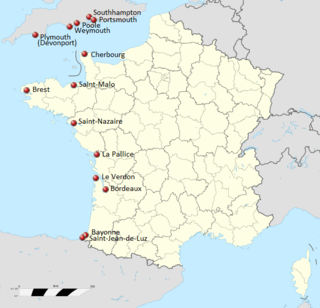
Operation Aerial was the evacuation of Allied forces and civilians from ports in western France from 15 to 25 June 1940 during the Second World War. The evacuation followed the Allied military collapse in the Battle of France against Nazi Germany. Operation Dynamo, the evacuation from Dunkirk, and Operation Cycle, an embarkation from Le Havre, finished on 13 June. British and Allied ships were covered from French bases by five Royal Air Force (RAF) fighter squadrons and assisted by aircraft based in England, to lift British, Polish and Czech troops, civilians and equipment from Atlantic ports, particularly from St Nazaire and Nantes.

The 51st (Highland) Division was an infantry division of the British Army that fought on the Western Front in France during the First World War from 1915 to 1918. The division was raised in 1908, upon the creation of the Territorial Force, as the Highland Division and later 51st (Highland) Division from 1915. The division's insignia was a stylised 'HD' inside a red circle. Early doubts about the division's performance earned it the nickname of "Harper's Duds" after the name of its commander, Major-General George Harper.

The 43rd (Wessex) Infantry Division was an infantry division of Britain's Territorial Army (TA). The division was first formed in 1908, as the Wessex Division. During the First World War, it was broken-up and never served as a complete formation. It was reformed in the TA in 1920, and then served in the campaign in North West Europe from June 1944 until May 1945, during the Second World War. The division suffered heavy casualties and gained an excellent reputation. After the Second World War, the division formed part of the postwar TA, and became the 43rd (Wessex) Division/District in 1961. It was finally disbanded in 1967.
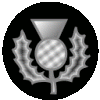
The 9th (Highland) Infantry Division was an infantry division of the British Army, formed just prior to the start of the Second World War. In March 1939, after the re-emergence of Germany as a significant military power and its occupation of Czechoslovakia, the British Army increased the number of divisions in the Territorial Army (TA) by duplicating existing units. The 9th (Highland) was formed in August 1939, as a second-line duplicate of the 51st (Highland) Infantry Division. The division's battalions were all raised in the Scottish Highlands.
The 150th Infantry Brigade was an infantry formation of the British Army that saw active service in the Second World War. A 1st Line Territorial Army brigade, it was part of the 50th (Northumbrian) Infantry Division. It served in the Battle of France and was evacuated from Dunkirk. Later it served in the Middle East and was overrun and forced to surrender during the Battle of Gazala in the North African Campaign. For almost 72 hours during the battle the 150th Brigade and the 44th Royal Tank Regiment held out against Erwin Rommel's concentrated attacks, without any support. On 1 June the German Army finally forced their surrender. The brigade was not reformed.

The 6th Armoured Division was an armoured division of the British Army, created in September 1940 during the Second World War and re-formed in May 1951 in the UK.
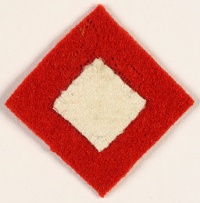
The 42nd Armoured Division was an armoured division of the British Army raised during the Second World War.

The Second Battle of El Alamein was a battle of the Second World War that took place near the Egyptian railway halt of El Alamein. The First Battle of El Alamein and the Battle of Alam el Halfa had prevented the Axis from advancing further into Egypt.
227th Brigade was an infantry formation of the British Army formed for Home Service under various short-lived titles in the First and the Second World Wars. Later it was upgraded to a field formation composed of Scottish troops, and saw heavy fighting in the Normandy and North West Europe Campaign.
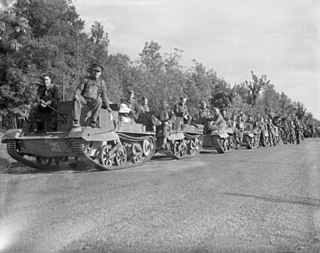
The British Expeditionary Force (BEF) was the name of the contingent of the British Army sent to France in 1939 after Britain and France declared war on Nazi Germany on 3 September, beginning the Second World War. The BEF existed from 2 September 1939 when the BEF GHQ was formed until 31 May 1940, when GHQ closed down and its troops reverted to the command of Home Forces. During the 1930s, the British government had planned to deter war by abolishing the Ten Year Rule and rearming from the very low level of readiness of the early 1930s. The bulk of the extra money went to the Royal Navy and the Royal Air Force but plans were made to re-equip a small number of Army and Territorial Army divisions for service overseas.
Battle of Monte Cassino order of battle January 1944 is a listing of the significant formations that were involved in the fighting on the Winter Line January 1944 during the period generally known as the First Battle of Monte Cassino.

The Beauman Division was an improvised formation of the British Expeditionary Force (BEF) during the Second World War, which fought in France against the German 4th Army in June 1940, during Fall Rot, the final German offensive of the Battle of France.
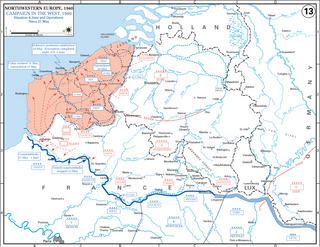
The Battle of Abbeville took place from 27 May to 4 June 1940, near Abbeville during the Battle of France in the Second World War. On 20 May, the 2nd Panzer Division advanced 56 mi (90 km) to Abbeville on the English Channel, overran the 25th Infantry Brigade of the 50th (Northumbrian) Infantry Division and captured the town at 8:30 p.m. Only a few British survivors managed to retreat to the south bank of the Somme and at 2:00 a.m. on 21 May, the III Battalion, Rifle Regiment 2 reached the coast, west of Noyelles-sur-Mer.

The 144th Regiment Royal Armoured Corps was an armoured regiment of the British Army. Originally raised during World War II as a battalion of the East Lancashire Regiment it was later transferred to the Royal Armoured Corps. It fought in the campaign in North-West Europe, from June 1944 to May 1945.
The 107th Regiment Royal Armoured Corps was a tank regiment of the Royal Armoured Corps, raised by the British Army during the Second World War. The regiment served with distinction in North-west Europe from July 1944 to May 1945.

The 12th (Eastern) Infantry Division was an infantry division of the British Army, which fought briefly in the Battle of France during the Second World War. In March 1939, after the re-emergence of Germany as a European power and its occupation of Czechoslovakia, the British Army increased the number of divisions within the Territorial Army by duplicating existing units. The 12th (Eastern) Infantry Division was formed in October 1939, as a second-line duplicate of the 44th Infantry Division.
The Shropshire Royal Horse Artillery was a Territorial Force Royal Horse Artillery battery that was formed in Shropshire in 1908 from the Shropshire Battery of the 1st Shropshire and Staffordshire Artillery Volunteers, Royal Garrison Artillery of the Volunteer Force. It saw active service during the First World War on the Western Front in 1917 and 1918 as part of an Army Field Artillery Brigade. A second line battery, 2/1st Shropshire RHA, also served on the Western Front in 1917 and 1918 as part of another Army Field Artillery Brigade. It was reconstituted post-war as a medium artillery battery and served as such in the Second World War.
The North Midland (Staffordshire) Heavy Battery was a Territorial Force (TF) unit of the Royal Garrison Artillery (RGA) formed in Staffordshire in 1908. It fought on the Western Front during World War I. Converted to medium artillery in the 1920s, the unit took part in the Battle of France and Dunkirk Evacuation in the early part of World War II, before returning to action in North Africa and Italy, and finally in North West Europe.
The 1st Argyll & Bute Artillery Volunteers was a part-time unit of the British Army's Royal Artillery formed in Scotland in 1860 in response to a French invasion threat. It 1908 it became the only Mountain Artillery unit in the Territorial Force, and saw action at Gallipoli and Salonika during World War I. Before World War II it became the first Territorial Anti-Tank unit. One of its successor units was captured at Saint-Valery-en-Caux during the Battle of France, but others saw action in the campaigns in North Africa and Sicily, and in North West Europe from D Day to VE Day, including Arnhem and the Rhine Crossing. It continued in the postwar Territorial Army until 1955.